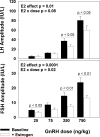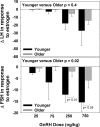Estrogen negative feedback on gonadotropin secretion: evidence for a direct pituitary effect in women
- PMID: 20133465
- PMCID: PMC2853991
- DOI: 10.1210/jc.2009-2108
Estrogen negative feedback on gonadotropin secretion: evidence for a direct pituitary effect in women
Abstract
Context: Studies in humans and animals indicate that estrogen negative feedback occurs at the level of the hypothalamus, but it is unclear whether estrogen also exerts an inhibitory effect directly at the pituitary.
Objectives: The aim of the study was to determine whether estrogen has a direct negative feedback effect at the pituitary and whether this varies with aging.
Design and setting: A GnRH antagonist and graded doses of GnRH were used to isolate pituitary responsiveness before and after estrogen administration in Clinical Research Center studies at an academic medical center.
Subjects: Subjects were healthy postmenopausal women aged 48-56 yr (n = 8) or 70-75 yr (n= 8).
Interventions: A suppressive dose of the NAL-GLU GnRH antagonist was administered, followed by graded doses of GnRH before and after 1 month of estrogen administration.
Results: LH and FSH responses to GnRH decreased after estrogen administration (P = 0.01 and P = 0.0001, respectively). The ratio of FSH to LH amplitudes decreased in response to estrogen (P = 0.04) indicating a greater sensitivity of FSH than LH to inhibition by estrogen. The inhibitory effect of estrogen on FSH was attenuated with aging (P = 0.02), but was maintained for LH (P = 0.4).
Conclusions: Studies that control for endogenous GnRH and estradiol demonstrate a direct pituitary site of estrogen negative feedback on LH and FSH responsiveness to GnRH in women. The effect of estrogen on FSH responsiveness is greater than on LH and is attenuated with aging. These studies indicate that estrogen negative feedback occurs directly at the pituitary and contributes to the differential regulation of FSH and LH secretion.
Trial registration: ClinicalTrials.gov NCT00386022.
Figures




References
-
- Crowley Jr WF, Filicori M, Spratt DI, Santoro NF 1985 The physiology of gonadotropin-releasing hormone (GnRH) secretion in men and women. Recent Prog Horm Res 41:473–531 - PubMed
-
- Loumaye E, Catt KJ 1982 Homologous regulation of gonadotropin-releasing hormone receptors in cultured pituitary cells. Science 215:983–985 - PubMed
-
- Ando H, Hew CL, Urano A 2001 Signal transduction pathways and transcription factors involved in the gonadotropin-releasing hormone-stimulated gonadotropin subunit gene expression. Comp Biochem Physiol B Biochem Mol Biol 129:525–532 - PubMed
-
- Clarke IJ 2002 Multifarious effects of estrogen on the pituitary gonadotrope with special emphasis on studies in the ovine species. Arch Physiol Biochem 110:62–73 - PubMed
-
- Gregory SJ, Kaiser UB 2004 Regulation of gonadotropins by inhibin and activin. Semin Reprod Med 22:253–267 - PubMed
Publication types
MeSH terms
Substances
Associated data
Grants and funding
LinkOut - more resources
Full Text Sources
Medical

